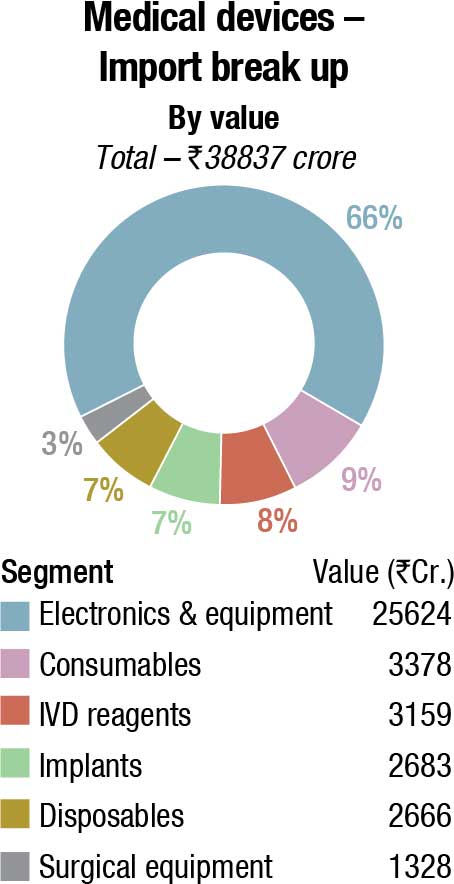MB's Take
Realizing the full potential of Make in India

While the Make in India program is moving in the right direction, how it will be structured, enacted, developed, and promulgated over the coming months will decide the absolute impact of the initiative on the development of the medical devices industry.
The ambitious Make in India initiative, launched by the Indian government, is aimed at helping skill development, facilitating cash inflows, building infrastructure, growing manufacturing infrastructure, and protecting intellectual property. The initiative, though, has challenges of its own, multiple business sectors have made use of this opportunity. Driven by the favorable changes and the ease of doing business, due to policy restructuring and the creation of a favorable business environment owing to the Make in India campaign, medical devices manufacturers are greatly interested in establishing manufacturing units in the country while existing manufacturers aim to expand their capabilities. The potential of Make in India is great for the medical devices; however, there are certain gaps that need to be plugged.
In the healthcare sector, for Make in India to meet its objective, the government, industry (medical devices manufacturers, health insurance providers, and healthcare personnel), and other stakeholders (educational institutions, research facilities, and funding agencies) must all work in tandem with one another to encourage local manufacturing. The Indian government is a key contributor in creating favorable policy and regulatory requirement, as well as putting up framework for the development of indigenous medical devices production. As a reciprocal, the industry must coordinate with the government to encourage generation of novel ideas and indigenization among its members, consequently, facilitating access to cost-effective and superior healthcare services.
Duties of the government
The government has multiple roles to play, which include drafting policies, acting as a regulatory agency for the management and proliferation of medical devices, and a provider of favorable atmosphere for the healthcare sector to grow. Also, the government can act as a consumer for locally manufactured medical devices and health technologies. Further to this, the government is also required to ensure favorable atmosphere for business.
Government as the maker of policies for the medical devices sector
Suitable regulatory framework and well-defined policies act as a move in the right direction in creating and facilitating an atmosphere conducive for bulk indigenous manufacturing of various medical technologies. These actions are a reflective of the government’s view toward the medical devices industry and the healthcare industry as a whole, which translates into developing India as a growing hub for medical technologies.
The government could implement the following policies:
- Separate regulations for medical devices. While the medical devices industry is way too different from the pharmaceutical industry, the Drugs and Cosmetics (Amendment) Bill 2015 still remains pending in the Parliament. The bill needs to be taken up on priority to facilitate the medical devices industry in establishing a distinct identity; only then can independent regulations for the medical devices industry be drafted.
- Offering grants and incentives to the medical devices sector. Various financial measures can be taken to provide an impetus to medical devices sector with a prime focus toward the initial stages of developing the manufacturing ecosystem. For instance:
- Offering CENVAT/duty credit on raw materials. The government must ensure that a suitable mechanism is developed so that the industry can maintain duty parity on raw materials and finished goods.
- Offering tax cuts, subsidies and easy financing for import of medical devices manufacturing units/machinery/spare parts. Tax cuts and subsidies would facilitate import of spare parts and other consumables for medical devices manufacturing.
- Conforming to the standards laid down by leading regulatory agencies (FDA or FDA equivalent). In order to compete with products from other countries, indigenously manufactured medical technologies must comply with the standards set by leading pharma regulators (FDA). This would require local manufacturers align their quality standards and processes with international standards. The government can facilitate medical devices manufacturers gain swift and costeffective access to FDA (or equivalent) certifications. This can be done by establishing a fast-track mechanism for FDA accreditation and by subsidizing certification costs.
- Category-based incentives. Product category ranging from low- to mid-level medical technologies that are already being manufactured in India can be prioritized for a short term, and the sophisticated technologies can be prioritized for a long-term focus.
- Region-based benefits. The government can provide benefits like low land acquisition costs, training subsidies, cost-effective energy, etc., to states that intend to develop a medical devices manufacturing unit.

The role of the government as a policy maker, and as a development institute for medical devices value chain:
The government plays a crucial role in growing the entire ecosystem (comprising of suppliers, distributors, buyers, etc.) of the medical devices industry. Having probably the largest network of hospitals, medical colleges, primary healthcare settings and other elements of the medical infrastructure also, the government is one of the largest consumers of medical devices. Various public welfare initiatives run by the government necessitate the use of medical devices and diagnostics.
In this scenario, the government should undertake various steps. The most crucial ones:
- Preferential treatment to domestically manufactured products in procurement. To encourage domestic manufacturing, the government can prefer procurement of indigenously manufactured medical technologies. Considering the bulk of government purchase, this step would provide a major boost to various Indian medical devices manufacturers.
- Easing regulatory or purchase requirement for indigenously manufactured medical devices and technologies. For indigenous manufacturers, protocols could be simplified and processes could be eased for regulatory submissions and obtaining required permits and licenses. Existing irregularities can be simplified to provide Indian manufacturers a launchpad for growth and development.
- Increased compensation for domestically manufactured products. Healthcare sector is financed by the government and private insurance entities. Any kind of preference in compensation for indigenously manufactured products would be advantageous for the Indian manufacturing sector.
- Expanding skill initiatives to superior-technology manufacturing. Various initiatives launched as a part of the Skill India campaign can be expanded to high-technology segment of the medical devices industry. Available manpower for manufacturing, handling, and research and development of medical devices should be upgraded.
- Availability of subsidized/cheaper funding. Medical devices manufacturers need sufficient amount of funds. The availability of funds at low interest would be an impetus for Indian industries to set up or expand their manufacturing capabilities. The government can support the process by maintaining cash reserves that would offer funds for indigenous medical devices manufacturing at considerably lower interest rate.
- Promote innovation, research, and domestic products. To create domestic demand, innovation and manufacturing must be in sync. Products conceptualized and designed in India are best suited for the Indian market. The required infrastructure comprising of technology parks, research facilities, incubation centers, and funding sources, would help drive innovation and manufacturing in India.
The government’s role as a policymaker for the economic environment for the Make in India Initiative:
The role of the government as a policymaker for the economic environment that holds up the Make in India program would have a notable effect on the medical devices industry. Given the fact there are provisions focused on the medical devices/healthcare industry, the wider perspectives with respect to manufacturing in India are unrelated to the industry and require to be taken care of, consistently.
Some of them could be:
- Simplifying the ease of doing business. Several features like bureaucracy, permits and license protocols, various levels of approvals, etc., must be considered to encourage global and Indian organizations and businesses to manufacture in India. Creation of single point of contact for establishing manufacturing units would work the best.
- Developing a favorable image of Brand India. The government has given a push to the Make in India initiative in almost every sector. It must be ensured that a favorable image of India is proliferated, using Make in India as a platform. Measures must be undertaken to outshine the USPs of goods manufactured in India.
The role of the health industry
- In order to fully utilize the benefits of Make in India, the health sector must work in coordination with government initiatives, using policy and regulatory changes. Medical devices manufacturers (Indian or multinational) and other stakeholders (healthcare providers, insurers, etc.) have an important role to play in making the Make in India initiative a success. In addition to this, the role of professional associations, industry segments, funding agencies, etc., is important to support the progress of the manufacturing infrastructure.
- Engage in profitable India-centric innovation in tandem with domestic manufacturing. Make in India and Innovate in India can be combined to develop superior India-based technologies. Collaboration of multinationals with Indian companies would improve profitability and reduce time to market. Being cost-effective in nature, these technologies can be attractive to both developing and underdeveloped markets.
- Revisiting the operation of the Indian market. International giants like the Indian health tech majors must review and revise their operational system in India. Product- or segment-oriented strategies need to be created and existing strategies need to be updated so that the low- to medium-tech medical devices that are already under development in India can be manufactured in large quantities. Partnering with healthcare delivery players would further pave the way for new business ideas
While the Make in India program is moving in the right direction, how it will be structured, enacted, developed, and promulgated over the coming months will decide the absolute impact of the initiative on the development of the medical devices industry and the health sector, as an extension. Through collaborative transformation, a turning point in the Indian healthcare industry can be achieved in which appropriate government actions, emphasis on local innovation, and the overarching goal of making India a hotspot for the manufacture of medical devices, can act as driving forces.














